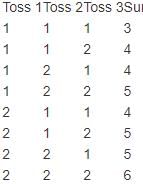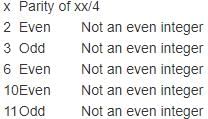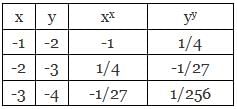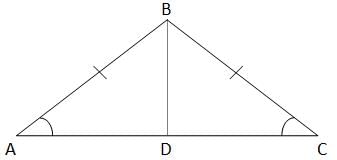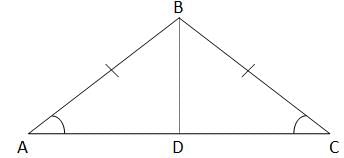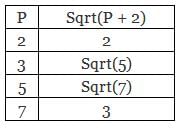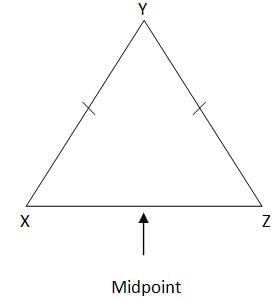GMAT Classic Mock Test - 6 - GMAT MCQ
30 Questions MCQ Test - GMAT Classic Mock Test - 6
A test maker is to design a probability test from a list of 21 questions. The 21 questions are classified into three categories: hard, intermediate and easy. If there are 7 questions in each category and the test maker is to select two questions from each category, how many different combinations of questions can the test maker put on the test?
If the sum of the consecutive integers from –35 to n inclusive is 150, what is the value of n?A
A box contains either blue or red flags. The total number of flags in the box is an even number. A group of children are asked to pick up two flags each. If all the flags are used up in the process such that 60% of the children have blue flags, and 55% have red flags, what percentage of children have flags of both the colors?
A coin has two sides. One side has the number 1 on it and the other side has the number 2 on it. If the coin is flipped three times what is the probability that the sum of the numbers on the landing side of the coin will be greater than 4?
There are five empty chairs in a row. If six men and four women are waiting to be seated, what is the probability that the seats will be occupied by two men and three women?
In baseball, the batting average is defined as the ratio of a player’s hits to at bats. If a player had anywhere from 4 to 6 at bats in a recent game and had anywhere from 2 to 3 hits in the same game, the player’s actual batting average for that game could fall anywhere between
Let f(x) = x2 + bx + c. If f(1) = 0 and f(-4) = 0, then f(x) crosses the y-axis at what y-coordinate?
Superior Security recently discovered a computer on its network had been hacked. The computer password contained 16 characters (including only numbers and letters). What is the probability that the password to Superior’s hacked computer was correctly guessed on the first try? (Assume that the hacker knew the password contained 16 characters, comprised only of numbers and both lower-case and upper-case letters.)
The average (arithmetic mean) of a and b is 90; the average (arithmetic mean) of a and c is 150; what is the value of (b-c)/2?
f(x) = x2 + 4x + k = 12; f(-6) = 0; if k is a constant and n is the number for which f(n) = 0, what is the value of n?
A computer has three hard-drives; the smallest and largest hard-drives account for 25 and 45 percent of the total storage space on the computer, respectively; due to a catastrophic error, the largest hard-drive lost approximately 22% of its storage space; after this error, the hard drive that was originally the second largest accounts for approximately what percent of the total hard-drive space on the reduced computer?
Chef Martha is preparing a pie for a friend's birthday. How much more of substance X does she need than substance Y?
(1) Martha needs 10 cups of substance X
(2) Martha needs the substances W, X, Y, and Z in the ratio: 15:5:2:1 and she needs 4 cups of substance Y
How many computers did Michael, a salesman for the computer company Digital Electronics Labs, sell this past year that had more than 4GB of RAM and the Microsoft Windows Vista operating system? (Michael sold no computers with exactly 4GB of RAM)
(1) 40% of the 200 total computers that Michael sold had Vista and less than 4GB of RAM; these computers represent 80% of the total computers that Michael sold with Vista.
(2) 50% of the 200 total computers that Michael sold had Vista; Of the computers that Michael sold without Vista, half had more than 4GB of ram while the other half had less than 4GB of RAM.
x is a positive integer; is x + 17, 283 odd?
(1) x - 192, 489, 358, 935 is odd
(2) x/4 is not an even integer
If n is a positive integer, is n + 2 > z?
(1) z2 > n
(2) z – n < 0
Peter can drive to work via the expressway or via the backroads, which is a less delay-prone route to work. What is the difference in the time Peter would spend driving to work via the expressway versus the backroads?
(1) Peter always drives 60mph, regardless of which route he takes; it takes Peter an hour to drive round-trip to and from work using the backroads
(2) If Peter travels to and from work on the expressway, he spends a total of 2/3 of an hour traveling
a, b, c, and d are integers; abcd≠0; what is the value of cd?
(1) c/b = 2/d
(2) b3a4c = 27a4c
If angle ABC is 30 degrees, what is the area of triangle BCE?
(1) Angle CDF is 120 degrees, lines L and M are parallel, and AC = 6, BC = 12, and EC = 2AC
(2) Angle DCG is 60 degrees, angle CDG is 30 degrees, angle FDG = 90, and GC = 6, CD = 12 and EC = 12
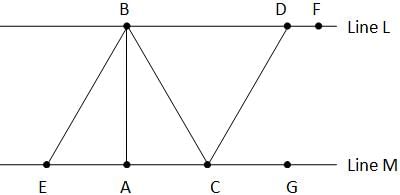
If both x and y are positive integers less than 100 and greater than 10, is the sum x + y a multiple of 11?
(1) x - y is a multiple of 22
(2) The tens digit and the units digit of x are the same; the tens digit and the units digit of y are the same
If b is prime and the symbol # represents one of the following operations: addition, subtraction, multiplication, or division, is the value of b # 2 even or odd?
1. (b # 1) # 2 = 5
2. 4 # b = 3 # (1 # b) and b is even
If x and y are both integers, which is larger, xx or yy?
- x = y + 1
- xy > x and x is positive.
A: x2 + 6x - 40 = 0
B: x2 + kx + j = 0
Which is larger, the sum of the roots of equation A or the sum of the roots of equation B?
- j = k
- k is negative
Given that A = 3y + 8x, B = 3y - 8x, C = 4y + 6x, and D = 4y - 6x, what is the value of x*y?
- AB + CD = -275
- AD - BC = 420
After a long career, John C. Walden is retiring. If there are 25 associates who contribute equally to a parting gift for John in an amount that is an integer, what is the total value of the parting gift?
- If four associates were fired for underperformance, the total value of the parting gift would have decreased by $200
- The value of the parting gift is greater than $1,225 and less than $1,275
f n and k are integers and (-2)n5 > 0, is k37 < 0?
- (nk)z > 0, where z is an integer that is not divisible by two
- k < n
What is the area of isosceles triangle X?
- The length of the side opposite the single largest angle in the triangle is 6cm
- The perimeter of triangle X is 16cm
For a set of 3 numbers, assuming there is only one mode, does the mode equal the range?
- The median equals the range
- The largest number is twice the value of the smallest number
Q is less than 10. Is Q a prime number?
- Q2 - 2 = P; P is prime and P < 10.
- Q + 2 is NOT prime, but Q is a positive integer.
X, Y, and Z are three points in space; is Y the midpoint of XZ?
- ZY and YX have the same length
- XZ is the diameter of a circle with center Y



